Vibration Energy Harvesting from the Subwavelength Interface State of a Topological Metamaterial Beam
Abstract
:1. Introduction
2. Design of a Locally Resonant Metamaterial Beam
2.1. Mass-Spring Model
2.2. Beam Model
3. Subwavelength Interface State and Energy Harvesting
4. Robustness to Local Defect
5. Results
- (1)
- The subwavelength topological interface state can effectively localize the elastic wave energy at the conjunction, resulting in a significant improvement of output power.
- (2)
- Since the maximum deformation takes place at the local resonator rather than host beam, the piezoelectric transducer is recommended to be bonded at the parasitic beam.
- (3)
- The wave energy is always localized at the conjunction in the interface state regardless of the location and degree of local defect, which indicates that the proposed topological metamaterial beam owns a very good robustness to local defect and can be a promising solution to achieve robust vibration energy harvesting in practical implementation.
Author Contributions
Funding
Conflicts of Interest
References
- Liu, J.; Lu, Y.; Wang, Z.; Li, S.; Wu, Y. Three Frequency Up-Converting Piezoelectric Energy Harvesters Caused by Internal Resonance Mechanism: A Narrative Review. Micromachines 2022, 13, 210. [Google Scholar] [CrossRef] [PubMed]
- Chen, J.; Liu, X.; Wang, H.; Wang, S.; Guan, M. Design and Experimental Investigation of a Rotational Piezoelectric Energy Harvester with an Offset Distance from the Rotation Center. Micromachines 2022, 13, 388. [Google Scholar] [CrossRef] [PubMed]
- Chen, G.; Tang, L.; Mace, B.R. Modelling and analysis of a thermoacoustic-piezoelectric energy harvester. Appl. Therm. Eng. 2019, 150, 532–544. [Google Scholar] [CrossRef]
- Shi, G.; Tong, D.; Xia, Y.; Jia, S.; Chang, J.; Li, Q.; Wang, X.; Xia, H.; Ye, Y. A piezoelectric vibration energy harvester for multi-directional and ultra-low frequency waves with magnetic coupling driven by rotating balls. Appl. Energy 2022, 310, 118511. [Google Scholar] [CrossRef]
- Hou, C.; Li, C.; Shan, X.; Yang, C.; Song, R.; Xie, T. A broadband piezo-electromagnetic hybrid energy harvester under combined vortex-induced and base excitations. Mech. Syst. Signal Processing 2022, 171, 108963. [Google Scholar] [CrossRef]
- Leland, E.S.; Wright, P.K. Resonance tuning of piezoelectric vibration energy scavenging generators using compressive axial preload. Smart Mater. Struct. 2016, 15, 1413. [Google Scholar] [CrossRef]
- Wu, Y.; Li, S.; Fan, K.; Ji, H.; Qiu, J. Investigation of an ultra-low frequency piezoelectric energy harvester with high frequency up-conversion factor caused by internal resonance mechanism. Mech. Syst. Signal Process. 2022, 162, 108038. [Google Scholar] [CrossRef]
- Lan, C.; Chen, Z.; Hu, G.; Liao, Y.; Qin, W. Achieve frequency-self-tracking energy harvesting using a passively adaptive cantilever beam, Mech. Syst. Signal Process. 2021, 156, 107672. [Google Scholar] [CrossRef]
- Zhang, B.; Li, H.; Zhou, S.; Liang, J.; Gao, J.; Yurchenko, D. Modeling and analysis of a three-degree-of-freedom piezoelectric vibration energy harvester for broadening bandwidth. Mech. Syst. Signal Process. 2022, 176, 109169. [Google Scholar] [CrossRef]
- Stanton, S.C.; McGehee, C.C.; Mann, B.P. Reversible hysteresis for broadband magnetopiezoelastic energy harvesting. Appl. Phys. Lett. 2009, 95, 174103. [Google Scholar] [CrossRef]
- Fan, K.; Tan, Q.; Liu, H.; Zhang, Y.; Cai, M. Improved energy harvesting from low-frequency small vibrations through a monostable piezoelectric energy harvester. Mech. Syst. Signal Process. 2019, 117, 594–608. [Google Scholar] [CrossRef]
- Lan, C.; Liao, Y.; Hu, G.; Tang, L. Equivalent impedance and power analysis of monostable piezoelectric energy harvesters. J. Intel. Mat. Syst. Str. 2020, 31, 1697–1715. [Google Scholar] [CrossRef]
- Zhang, H.; Sui, W.; Yang, C.; Zhang, L.; Song, R.; Wang, J. An asymmetric magnetic-coupled bending-torsion piezoelectric energy harvester: Modeling and experimental investigation. Smart Mater. Struct. 2022, 31, 015037. [Google Scholar] [CrossRef]
- Erturk, A.; Hoffmann, J.; Inman, D.J. A piezomagnetoelastic structure for broadband vibration energy harvesting. Appl. Phys. Lett. 2009, 94, 254102. [Google Scholar] [CrossRef]
- Daqaq, M.F.; Masana, R.; Erturk, A.; Quinn, D.D. On the role of nonlinearities in vibratory energy harvesting: A critical review and discussion. Appl. Phys. Rev. 2014, 66, 040801. [Google Scholar] [CrossRef]
- Huang, Y.; Liu, W.; Yuan, Y.; Zhang, Z. High-energy orbit attainment of a nonlinear beam generator by adjusting the buckling level. Sensor. Actuat. A Phys. 2020, 321, 112164. [Google Scholar] [CrossRef]
- Li, H.; Ding, H.; Jing, X.; Qin, W.; Chen, L. Improving the performance of a tri-stable energy harvester with a staircase-shaped potential well. Mech. Syst. Signal Prcess. 2021, 159, 107805. [Google Scholar]
- Zhou, S.; Zuo, L. Nonlinear dynamic analysis of asymmetric tristable energy harvesters for enhanced energy harvesting. Commun. Nonlinear Sci. 2018, 61, 271–284. [Google Scholar] [CrossRef]
- Huang, D.; Zhou, S.; Litak, G. Analytical analysis of the vibrational tristable energy harvester with a RL resonant circuit. Nonlinear Dyn. 2019, 97, 663–677. [Google Scholar] [CrossRef]
- Lallart, M.; Zhou, S.; Yan, L.; Yang, Z.; Chen, Y. Tailoring multistable vibrational energy harvesters for enhanced performance: Theory and numerical investigation. Nonlinear Dyn. 2019, 96, 1283–1301. [Google Scholar] [CrossRef]
- Pan, J.; Qin, W.; Deng, W. Promote efficiency of harvesting vibration energy by tailoring potential energy with addition of magnets. AIP Adv. 2019, 9, 075323. [Google Scholar] [CrossRef] [Green Version]
- Chen, L.; Jiang, W. Internal resonance energy harvesting. J. Appl. Mech-T. ASME 2015, 82, 031004. [Google Scholar] [CrossRef]
- Wu, Y.; Qiu, J.; Zhou, S.; Ji, H.; Chen, Y.; Li, S. A piezoelectric spring pendulum oscillator used for multi-directional and ultra-low frequency vibration energy harvesting. Appl. Energy 2018, 231, 600–614. [Google Scholar] [CrossRef]
- Lan, C.; Tang, L.; Qin, W.; Xiong, L. Magnetically coupled dual-beam energy harvester: Benefit and trade-off. J. Intel. Mat. Syst. Str. 2018, 29, 1216–1235. [Google Scholar] [CrossRef]
- Mallick, D.; Amann, A.; Roy, S. Surfing the high energy output branch of nonlinear energy harvesters, Phys. Rev. Lett. 2016, 117, 197701. [Google Scholar] [CrossRef] [PubMed]
- Wang, J.; Liao, W. Attaining the high-energy orbit of nonlinear energy harvesters by load perturbation, Energy Convers. Manage. 2019, 192, 30–36. [Google Scholar]
- Carrara, M.; Cacan, M.; Toussaint, J.; Leamy, M.; Ruzzene, M.; Erturk, A. Metamaterial-inspired structures and concepts for elastoacoustic wave energy harvesting. Smart Mater. Struct. 2013, 22, 065004. [Google Scholar] [CrossRef]
- Tol, S.; Degertekin, F.L.; Erturk, A. Gradient-index phononic crystal lens-based enhancement of elastic wave energy harvesting. Appl. Phys. Lett. 2016, 109, 063902. [Google Scholar] [CrossRef]
- Gonella, S.; To, A.C.; Liu, W.K. Interplay between phononic bandgaps and piezoelectric microstructures for energy harvesting. J. Mech. Phys. Solids 2009, 57, 621–633. [Google Scholar] [CrossRef]
- Hu, G.; Tang, L.; Das, R. Internally coupled metamaterial beam for simultaneous vibration suppression and low frequency energy harvesting. J. Appl. Phys. 2018, 123, 055107. [Google Scholar] [CrossRef]
- Hu, G.; Tang, L.; Liang, J.; Lan, C.; Das, R. Acoustic-elastic metamaterials and phononic crystals for energy harvesting: A review. Smart Mater. Struct. 2021, 30, 085025. [Google Scholar] [CrossRef]
- Wang, W.; Jin, Y.; Wang, W.; Bonello, B.; Djafari-Rouhani, B.; Fleury, R. Roubst Fano resonance in a topological mechanical beam. Phys. Rev. B 2020, 101, 02401. [Google Scholar]
- Jin, Y.; Wang, W.; Djafari-Rouhani, B. Asymmetric topological state in an elastic beam based on symmetry principle. Int. J. Mech. Sci. 2020, 186, 105897. [Google Scholar] [CrossRef]
- He, L.; Guo, H.; Jin, Y.; Zhuang, X.; Robczuk, T.; Li, Y. Mechine-learning-driven on-demand design of phononic beams. Sci. China Phys. Mech. 2022, 65, 214612. [Google Scholar] [CrossRef]
- Fan, L.; He, Y.; Zhao, X.; Chen, X.A. Subwavelength and broadband tunable topological interface state for flexural wave in one-dimensional locally resonant phononic crystal. J. Appl. Phys. 2020, 127, 235106. [Google Scholar] [CrossRef]
- Lan, C.; Hu, G.; Tang, L.; Yang, Y. Energy Localization and Topological Protection of a Locally Resonant Topological Metamaterial for Robust Vibration Energy Harvesting. J. Appl. Phys. 2021, 129, 184502. [Google Scholar] [CrossRef]
- Ma, T.; Fan, Q.; Zhang, C.; Wang, Y. Flexural wave energy harvesting by the topological interface state of a phononic crystal beam. Extrem. Mech. Lett. 2022, 50, 101578. [Google Scholar] [CrossRef]
- Wen, Z.; Jin, Y.; Gao, P.; Zhuang, X.; Rabczuk, T.; Diafari-Rouhani, B. Topological cavities in phononic plates for robust energy harvesting. Mech. Syst. Signal Pract. 2022, 162, 108047. [Google Scholar] [CrossRef]
- Su, W.; Schrieffer, J.R.; Heeger, A.J. Solitons in polyacetylene. Phys. Rev. Lett. 1979, 42, 1698. [Google Scholar] [CrossRef]
- Yin, J.; Ruzzene, M.; Wen, J.; Yu, D.; Cai, L.; Yue, L. Band transition and topological interface modes in 1D elastic phononic crystals. Sci. Rep. 2018, 8, 1–10. [Google Scholar] [CrossRef]
- Zhou, W.; Lim, C.W. Topological edge modeling and localization of protected interface modes in 1D phononic crystals for longitudinal and bending elastic waves. Int. J. Mech. Sci. 2019, 159, 359–372. [Google Scholar]
- Zhao, D.; Xiao, M.; Ling, C.W.; Chan, C.T.; Fung, K.H. Topological interface modes in local resonant acoustic systems. Phys. Rev. B 2018, 98, 014110. [Google Scholar] [CrossRef] [Green Version]
- Xiao, M.; Ma, G.; Yang, Z.; Sheng, P.; Zhang, Z.Q.; Chan, C.T. Geometric phase and band inversion in periodic acoustic systems. Nat. Phys. 2015, 11, 240–244. [Google Scholar] [CrossRef]



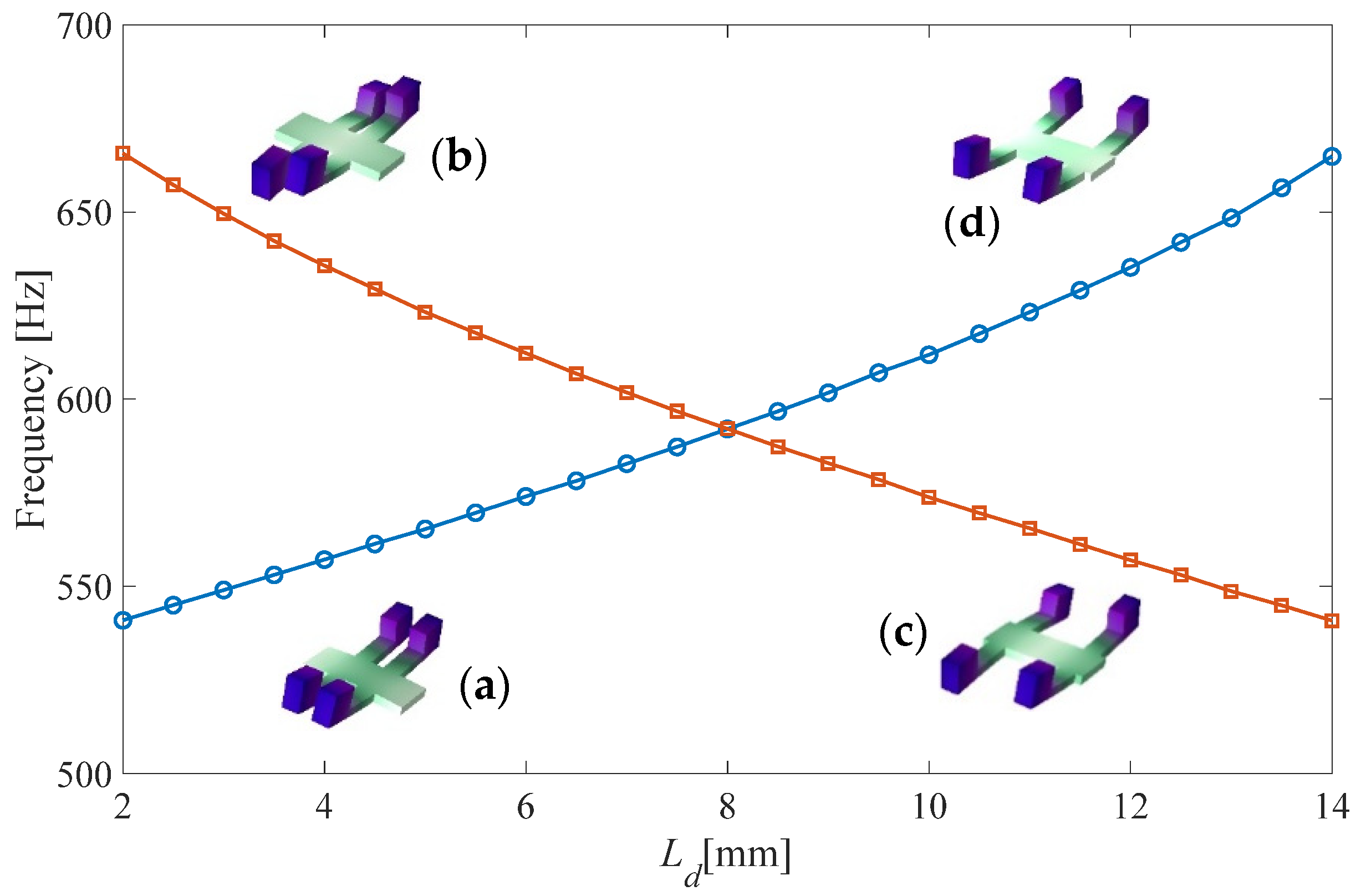
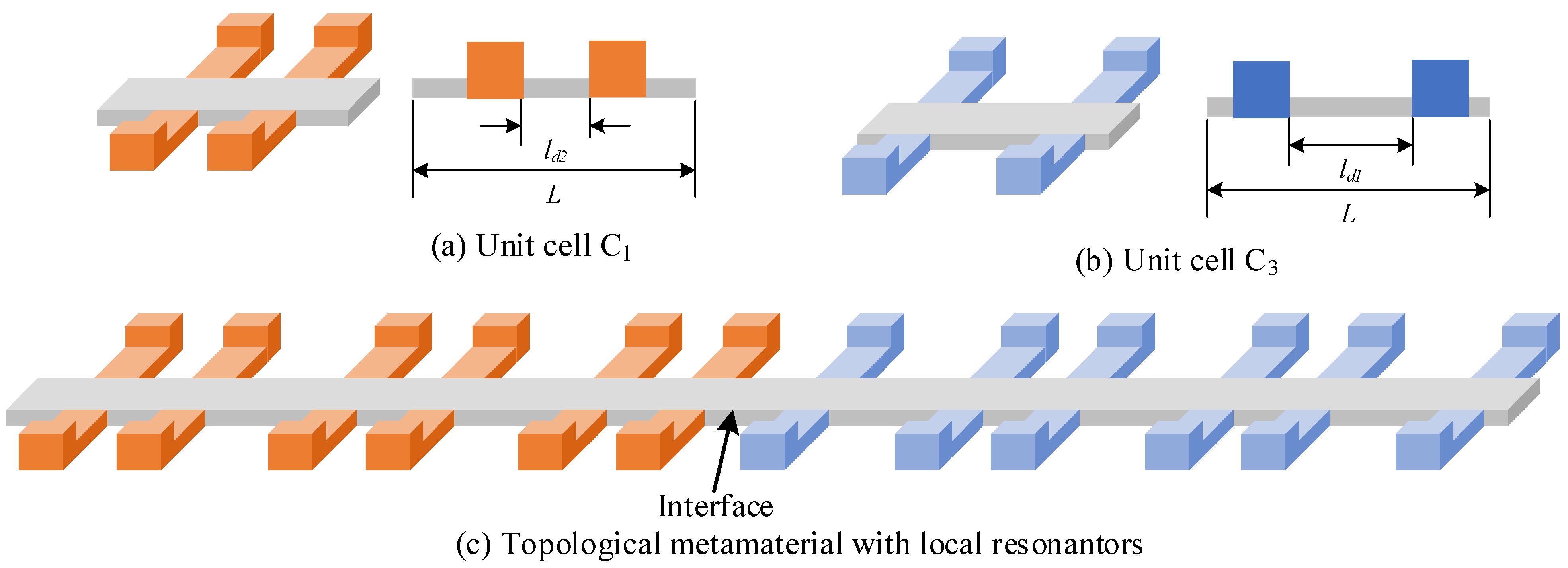
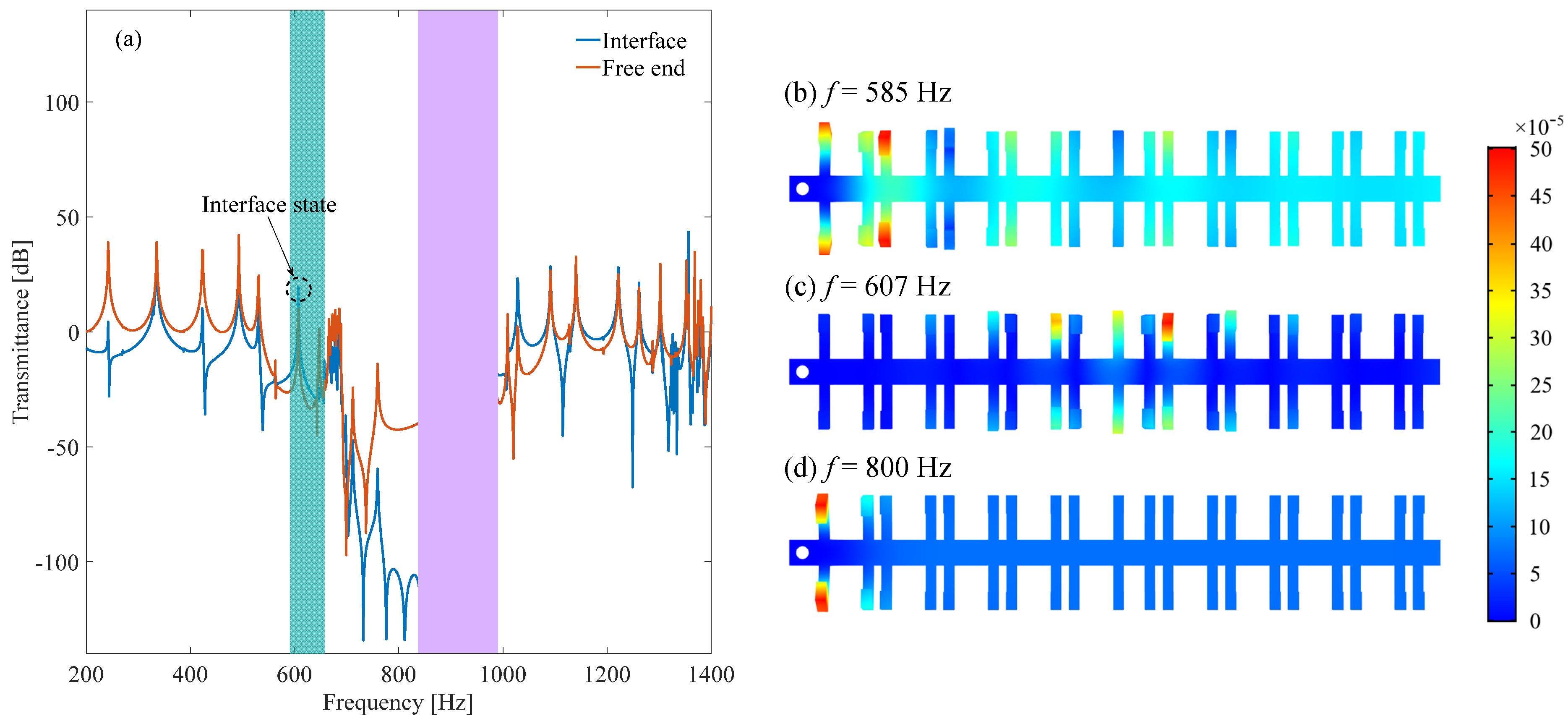
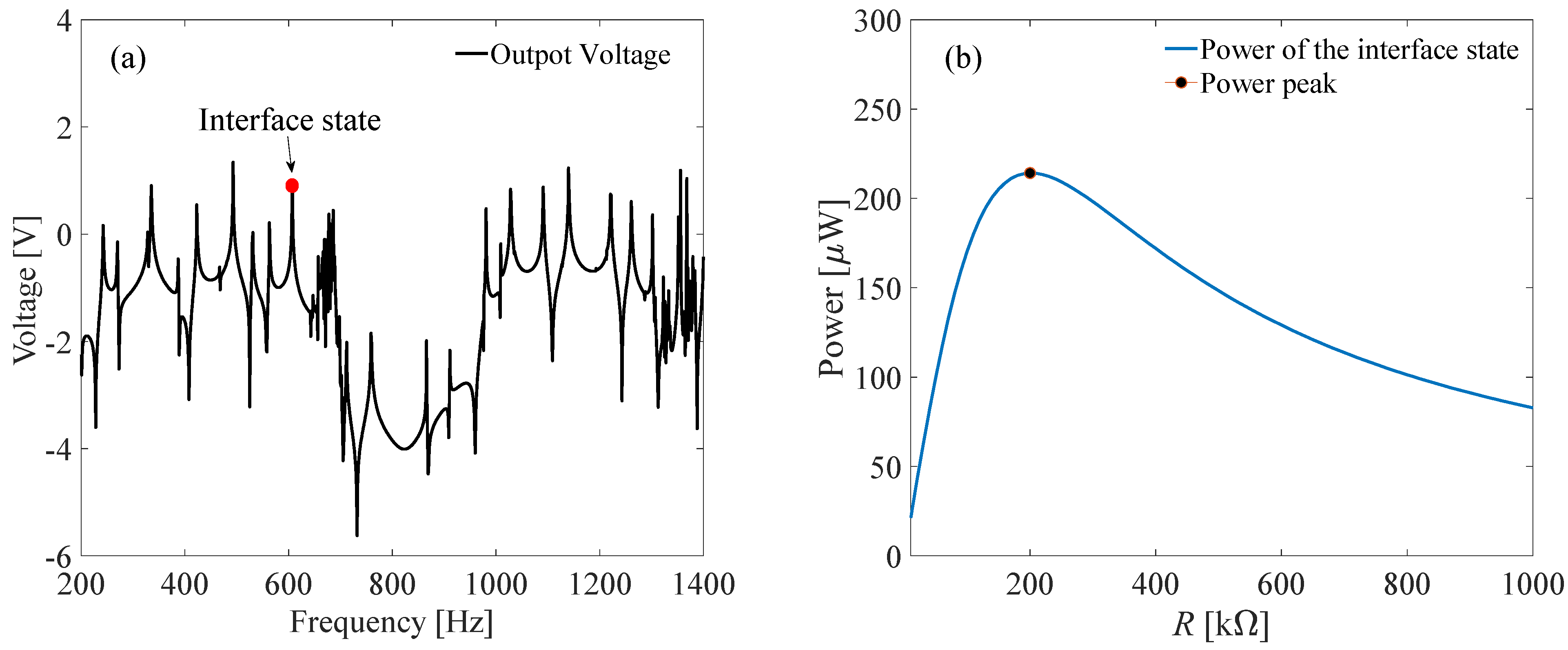
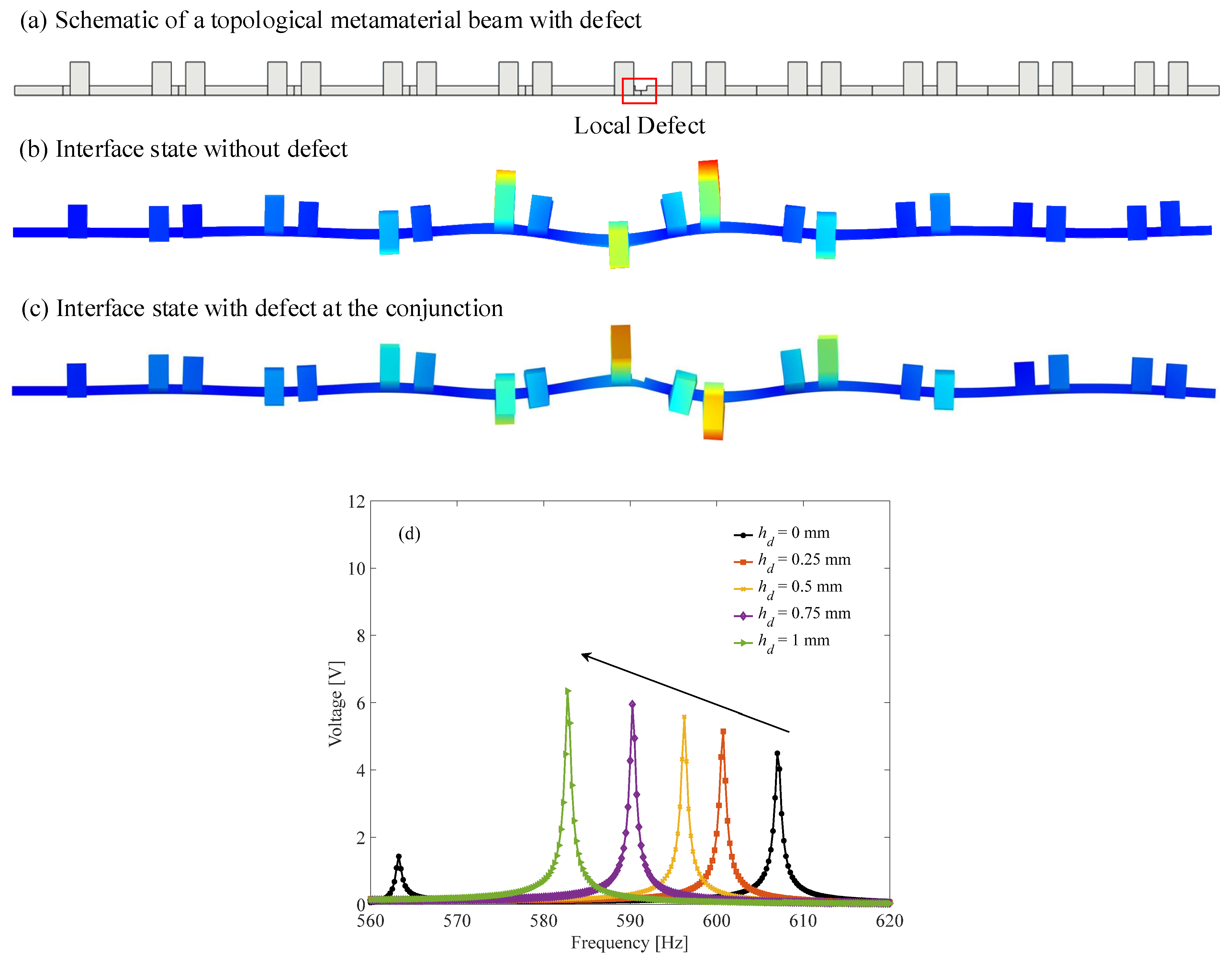

| Parameters | Value | Parameters | Value |
|---|---|---|---|
| Length of unit cell, L | 24 mm | Width/Hight of tip mass, hm | 7 mm |
| Width of host beam, b | 10 mm | Distance between two parasitic beams, ld | 4 mm |
| Height of main/parasitic beam, h | 2 mm | Material density, ρm | 1180 kg/m3 |
| Length of parasitic beam, lb | 10 mm | Poisson’s ratio, μ | 0.3 |
| Length of tip mass, lm | 4 mm | Yang’s Elastic Modulus, E | 2.5 Mpa |
Publisher’s Note: MDPI stays neutral with regard to jurisdictional claims in published maps and institutional affiliations. |
© 2022 by the authors. Licensee MDPI, Basel, Switzerland. This article is an open access article distributed under the terms and conditions of the Creative Commons Attribution (CC BY) license (https://creativecommons.org/licenses/by/4.0/).
Share and Cite
Lu, Y.; Wang, Z.; Zhu, X.; Hu, C.; Yang, J.; Wu, Y. Vibration Energy Harvesting from the Subwavelength Interface State of a Topological Metamaterial Beam. Micromachines 2022, 13, 862. https://doi.org/10.3390/mi13060862
Lu Y, Wang Z, Zhu X, Hu C, Yang J, Wu Y. Vibration Energy Harvesting from the Subwavelength Interface State of a Topological Metamaterial Beam. Micromachines. 2022; 13(6):862. https://doi.org/10.3390/mi13060862
Chicago/Turabian StyleLu, Yongling, Zhen Wang, Xueqiong Zhu, Chengbo Hu, Jinggang Yang, and Yipeng Wu. 2022. "Vibration Energy Harvesting from the Subwavelength Interface State of a Topological Metamaterial Beam" Micromachines 13, no. 6: 862. https://doi.org/10.3390/mi13060862
APA StyleLu, Y., Wang, Z., Zhu, X., Hu, C., Yang, J., & Wu, Y. (2022). Vibration Energy Harvesting from the Subwavelength Interface State of a Topological Metamaterial Beam. Micromachines, 13(6), 862. https://doi.org/10.3390/mi13060862







